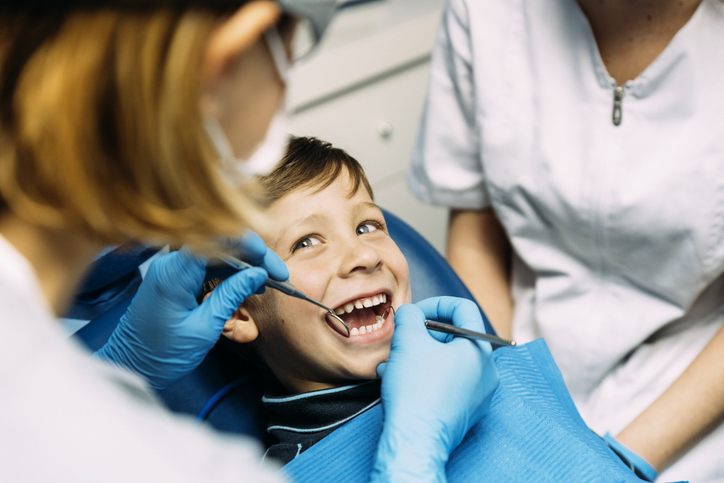Gum disease might seem like an adult problem, but children and teens are also at risk. While it often begins mildly, gum disease can escalate into serious issues if left untreated. Parents play an important role in protecting their children’s oral health by recognizing early warning signs, understanding the causes, and ensuring preventive measures are in place. Additionally, early intervention with a periodontist can set children up for healthier smiles and better overall well-being.
Understanding Gum Disease in Young People
Gum disease, also known as periodontal disease, is a bacterial infection that affects the gums and the structures supporting the teeth. It begins as gingivitis, which causes inflammation, redness, and bleeding of the gums. At this stage, gum disease is reversible with proper care. However, if neglected, it can progress to periodontitis—a more severe form of gum disease that can lead to irreversible damage, including gum recession, bone loss, and tooth loss.
While gum disease is less common in children than adults, certain factors make younger populations vulnerable, especially during hormonal changes associated with puberty. The earlier parents can detect and address the condition, the better the outcome for their child’s oral health.
Recognizing the Warning Signs
Children and teens may not always complain about discomfort, so it’s up to parents to monitor for symptoms that may indicate gum disease. One of the earliest and most noticeable signs is inflammation, which causes the gums to appear red and swollen. Healthy gums should be pink and firm, so any deviation from this warrants attention.
Bleeding gums are another common symptom, particularly during brushing or flossing. Some parents may assume this is normal, but any amount of bleeding is a sign that the gums are irritated or infected. Persistent bad breath, also known as halitosis, is often caused by the buildup of bacteria under the gumline. In more advanced cases, gum recession may occur, making the teeth appear longer. Teeth can even become loose or shift out of place when the supporting structures are compromised.
Being aware of these signs and addressing them promptly can prevent the disease from progressing to a point where it becomes more challenging to treat.
What Causes Gum Disease in Children and Teens?
Understanding the root causes of gum disease can help parents take steps to protect their children’s oral health. Poor oral hygiene is the most common culprit. When plaque—a sticky film of bacteria—builds up on teeth and is not properly removed through brushing and flossing, it hardens into tartar. This irritates the gums and leads to inflammation.
Hormonal changes during puberty further contribute to the risk of gum disease. Increased blood flow to the gums can make them more sensitive and reactive to irritants like plaque. This is why teens, in particular, are more likely to experience gum inflammation during this stage of life.
Diet also plays a significant role. Many children and teens consume sugary snacks and beverages, which feed harmful bacteria in the mouth. These bacteria produce acids and toxins that not only damage tooth enamel but also irritate the gums.
Other contributing factors include genetics, medical conditions like diabetes, and even habits like mouth breathing, which can dry out the gums and reduce saliva’s protective effects. Saliva plays a vital role in neutralizing acids and washing away bacteria, so a dry mouth creates an environment where gum disease can thrive.
The Importance of Prevention
Preventing gum disease starts with establishing a strong oral hygiene routine at home. Parents should teach their children how to brush their teeth effectively, using fluoride toothpaste and spending at least two minutes brushing twice daily. Flossing is equally important, as it removes plaque from between the teeth and under the gumline—areas that brushing alone cannot reach.
Again, dietary habits have a direct impact on gum health. Limiting sugary foods and drinks is essential for preventing bacterial growth. Instead, encourage a diet rich in fresh fruits, vegetables, whole grains, and lean proteins. These foods not only support overall health but also help maintain a healthy balance in the mouth.
Regular visits to the dentist are so important for monitoring oral health. During these visits, dental professionals, can remove plaque and tartar that cannot be addressed through home care alone. Additionally, fluoride treatments and dental sealants can provide an extra layer of protection against decay and gum disease.
Parents should also be mindful of their child’s changing needs during puberty. As we’ve already stated, hormonal shifts can make the gums more susceptible to inflammation, so it’s important to emphasize proper oral hygiene and schedule regular checkups during these years.
Why Early Intervention Matters
One of the most significant risks of untreated gum disease is its potential to cause permanent damage to the teeth and supporting structures. In severe cases, gum disease can lead to tooth loss, even in children and teens. The impact of losing a tooth at a young age extends beyond aesthetics—it can affect the alignment of surrounding teeth, create difficulties with chewing, and even impact speech development.
There are also systemic health concerns to consider. Gum disease is linked to conditions like heart disease, diabetes, and respiratory issues. By addressing gum health early, parents can help reduce the risk of these complications later in life.
Early intervention with a periodontist like Dr. Trujillo can make a substantial difference. Periodontists specialize in diagnosing and treating gum disease, offering advanced care that general dentists may not provide. They can perform deep cleanings to remove bacteria from below the gumline, recommend treatments to promote healing, and create customized care plans to maintain healthy gums.
How a Periodontist Can Help
A visit to Dr. Trujillo in Phoenix, AZ, can be particularly beneficial for children and teens showing signs of gum disease. His expertise is to assess the severity of the condition and provide targeted treatments. For mild cases, a thorough cleaning and improved oral hygiene routine may be sufficient. However, more advanced cases may require procedures like scaling and root planing or laser gum treatment, which involve deep cleaning below the gumline to remove bacteria and tartar buildup.
Periodontists like Dr. Trujillo also educate parents and children about maintaining healthy gums. He provides tailored advice based on the child’s specific needs, ensuring that prevention becomes a lifelong habit. With his guidance, parents can feel confident that they are taking the right steps to protect their child’s oral health.
Setting the Stage for Lifelong Health
Healthy gums in childhood lay the foundation for a lifetime of good oral health. By addressing gum disease early, parents can prevent complications that may affect their child’s quality of life. More importantly, they instill habits and routines that children will carry into adulthood, reducing the risk of oral health issues down the road.
If your child is showing signs of gum disease or is due for a preventive visit, don’t wait. Schedule a consultation with Dr. Trujillo to ensure your child’s gums are healthy and well cared for. Early action can make all the difference in preserving their smile—and their overall health.

Don’t Let Gum Issues Hold Your Child Back
Call Dr. Trujillo in Phoenix, AZ, for a personalized treatment plan! We want your child to feel confident and smile their best. Call today!





